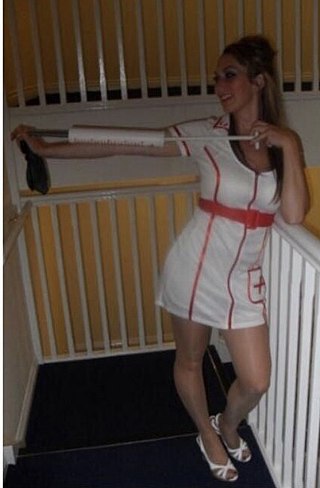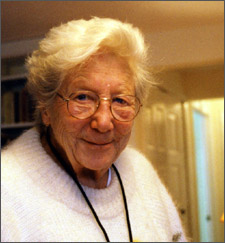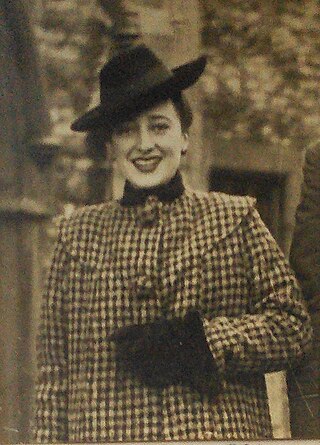Related Research Articles
Nurse education consists of the theoretical and practical training provided to nurses with the purpose to prepare them for their duties as nursing care professionals. This education is provided to student nurses by experienced nurses and other medical professionals who have qualified or experienced for educational tasks, traditionally in a type of professional school known as a nursing school of college of nursing. Most countries offer nurse education courses that can be relevant to general nursing or to specialized areas including mental health nursing, pediatric nursing, and post-operative nursing. Nurse education also provides post-qualification courses in specialist subjects within nursing.
Psychiatric nursing or mental health nursing is the appointed position of a nurse that specialises in mental health, and cares for people of all ages experiencing mental illnesses or distress. These include: neurodevelopmental disorders, schizophrenia, schizoaffective disorder, mood disorders, addiction, anxiety disorders, personality disorders, eating disorders, suicidal thoughts, psychosis, paranoia, and self-harm.

A stereotype is a widely held and fixed notion of a specific type of person and is often oversimplified and can be offensive. Stereotypes of people and groups are harmful, especially when they lack factual information. Nursing as a profession has been stereotyped throughout history. The stereotypes given to nursing as well as women in nursing has been well documented. A common misconception is that all nurses are female; this misconception has led to the emergence of another stereotype that male nurses are effeminate. These generalized perceptions of the nursing profession have aided in the misrepresentation of nurses in the media as well as the mischaracterization of nurses in the eyes of the public. The image of a nurse depicted by the media is typically of a female being over-sexualized as well as diminished intellectually. This notion is then portrayed in get-well cards, television, film and books. The over-sexualized nurse is commonly referred to as a naughty nurse and is often seen as a sex symbol or nymphomaniac. Along with these common stereotypes, studies have identified several other popular images used in media such as handmaiden, angel, torturer, homosexual male, alcoholic, buffoon and woman in white. Common stereotypes of nursing and portrayal of these misrepresentations have fueled a discussion on the effects they have on the profession.

The Voluntary Aid Detachment (VAD) was a voluntary unit of civilians providing nursing care for military personnel in the United Kingdom and various other countries in the British Empire. The most important periods of operation for these units were during World War I and World War II. Although VADs were intimately bound up in the war effort, they were not military nurses, as they were not under the control of the military, unlike the Queen Alexandra's Royal Army Nursing Corps, the Princess Mary's Royal Air Force Nursing Service, and the Queen Alexandra's Royal Naval Nursing Service. The VAD nurses worked in field hospitals, i.e., close to the battlefield, and in longer-term places of recuperation back in Britain.
Primary nursing is a system of nursing care delivery that emphasizes continuity of care and responsibility acceptance by having one registered nurse (RN), often teamed with a licensed practical nurse (LPN) and/or nursing assistant (NA), who together provide complete care for a group of patients throughout their stay in a hospital unit or department. While the patient is on the nurses' unit, the primary nurse accepts responsibility for administering some and coordinating all aspects of the patient's nursing care, with the support of other members of the nursing staff. This results in the nurse having greater insight into the patient's condition, both medical and emotional.

Emergency nursing is a specialty within the field of professional nursing focusing on the care of patients who require prompt medical attention to avoid long-term disability or death. In addition to addressing "true emergencies," emergency nurses increasingly care for people who are unwilling or unable to get primary medical care elsewhere and come to emergency departments for help. In fact, only a small percentage of emergency department (ED) patients have emergency conditions such as a stroke, heart attack or major trauma. Emergency nurses also tend to patients with acute alcohol and/or drug intoxication, psychiatric and behavioral problems and those who have been raped.

Florence Wald was an American nurse, former Dean of Yale School of Nursing, and largely credited as "the mother of the American hospice movement". She led the founding of Connecticut Hospice, the first hospice program in the United States. Late in life, Wald became interested in the provision of hospice care within prisons. In 1998, Wald was inducted into the National Women's Hall of Fame.
Validation therapy was developed by Naomi Feil for older people with cognitive impairments and dementia. Feil's own approach classifies individuals with cognitive impairment as having one of four stages in a continuum of dementia. These stages are:

Nursing is a health care profession that "integrates the art and science of caring and focuses on the protection, promotion, and optimization of health and human functioning; prevention of illness and injury; facilitation of healing; and alleviation of suffering through compassionate presence". Nurses practice in many specialties with varying levels of certification and responsibility. Nurses comprise the largest component of most healthcare environments. Shortages of qualified nurses are found in many countries.
Rufayda Al-Aslamia, was an Arab medical and social worker recognized as the first female Muslim nurse and the first female surgeon in Islam. She is known as the first nurse in the world.
In Islam, nurses provide healthcare services to patients, families and communities as a manifestation of love for Allah and Muhammad. The nursing profession is not new to Islam. Islamic traditions include sympathy for and responsibility toward those in need. This perspective had emerged during the development of Islam as a religion, culture, and civilization.
Unlicensed assistive personnel (UAP) are paraprofessionals who assist individuals with physical disabilities, mental impairments, and other health care needs with their activities of daily living (ADLs). UAPs also provide bedside care—including basic nursing procedures—all under the supervision of a registered nurse, licensed practical nurse or other health care professional. UAPs must demonstrate their ability and competence before gaining any expanded responsibilities in a clinical setting. While providing this care, UAPs offer compassion and patience and are part of the patient's healthcare support system. Communication between UAPs and registered nurses (RNs) is key as they are working together in their patients' best interests. The scope of care UAPs are responsible for is delegated by RNs or other clinical licensed professionals.

Holistic nursing is a way of treating and taking care of the patient as a whole body, which involves physical, social, environmental, psychological, cultural and religious factors. There are many theories that support the importance of nurses approaching the patient holistically and education on this is there to support the goal of holistic nursing. The important skill to be used in holistic nursing would be communicating skills with patients and other practitioners. This emphasizes that patients being treated would be treated not only in their body but also their mind and spirit.. Holistic nursing is a nursing speciality concerning the integration of one's mind, body, and spirit with his or her environment. This speciality has a theoretical basis in a few grand nursing theories, most notably the science of unitary human beings, as published by Martha E. Rogers in An Introduction to the Theoretical Basis of Nursing, and the mid-range theory Empowered Holistic Nursing Education, as published by Dr. Katie Love. Holistic nursing has gained recognition by the American Nurses Association (ANA) as a nursing specialty with a defined scope of practice and standards. Holistic nursing focuses on the mind, body, and spirit working together as a whole and how spiritual awareness in nursing can help heal illness. Holistic medicine focuses on maintaining optimum well-being and preventing rather than just treating disease.
A pediatric nurse practitioner (PNP) is a nurse practitioner who specializes in care for newborns, infants, toddlers, pre-schoolers, school-aged children, adolescents, and young adults. Nurse practitioners have an in-depth knowledge and experience in pediatric healthcare including well childcare, and prevention/management of common pediatric acute illnesses and chronic conditions. This care is provided to support optimal health of children within the context of their family, community, and environmental setting. In order to be a pediatric nurse practitioner one must be compassionate, resourceful, good at communicating and have good attention to detail.
Marie Schuber Manthey is an American nurse, author, and entrepreneur. She is recognized as one of the originators of Primary Nursing, an innovative system of nursing care delivery.

My Beautiful Broken Brain is a 2014 documentary film about the life of 34-year-old Lotje Sodderland after she suffered a hemorrhagic stroke as a result of a congenital vascular malformation in November 2011, initially experiencing aphasia, the complete loss of her ability to read, write, or speak coherently.

Barbara Robb was a British campaigner for the well-being of older people, best known for founding and leading the pressure group AEGIS and for the book Sans Everything: A Case to Answer.

Eileen Skellern FRCN (1923–1980) was an English psychiatric nurse who was involved in pioneering psychosocial and psychotherapeutic methods for treating patients. She helped open up new roles for nurses in mental health work, and demonstrated that they could be equal partners in a team, taking personal responsibility for patient care while collaborating with doctors and playing an important part in new developments in therapeutic treatment. While also taking a lead in education, administration and policy development, she did research and published in medical and nursing journals, and was a member of key committees in her field.
The Indiana University Libraries Moving Image Archive (IULMIA) is a major repository for nontheatrical film, video, and related archival materials located in Bloomington, Indiana.

Home Before Morning: The Story of an Army Nurse in Vietnam is a memoir written by American writer Lynda Van Devanter in 1983. The memoir, originally published by Beaufort Books, explores Van Devanter's experience as a nurse during the Vietnam War. It was adapted into a popular TV show, China Beach, which ran from 1988 to 1991.
References
- ↑ "2015 additions to the National Film Registry". CBS News . 2016-09-05. Archived from the original on 2019-11-22. Retrieved 2018-04-25.
- 1 2 3 "CINE/68". Journal of the University Film Association. 20 (3): 75–77. 1968. JSTOR 20686999.
- 1 2 3 "2015 National Film Registry: "Ghostbusters" Gets the Call". The Library of Congress. 2015-12-16. Archived from the original on 2022-03-24. Retrieved 2018-04-25.
- ↑ "Complete National Film Registry Listing". Library of Congress. Archived from the original on 2020-11-23. Retrieved 2020-11-16.
- 1 2 3 4 Diller, Leonard (January 1969). "The Treatment of Aphasia: A Film". PsycCRITIQUES. 14. American Psychological Association: 43–44 – via Portico.
- ↑ Marshall, E. G. (April 1969). "Films Screened". The American Journal of Nursing. 69 (4): 854–855. doi:10.1097/00000446-196904000-00054. JSTOR 3453849.